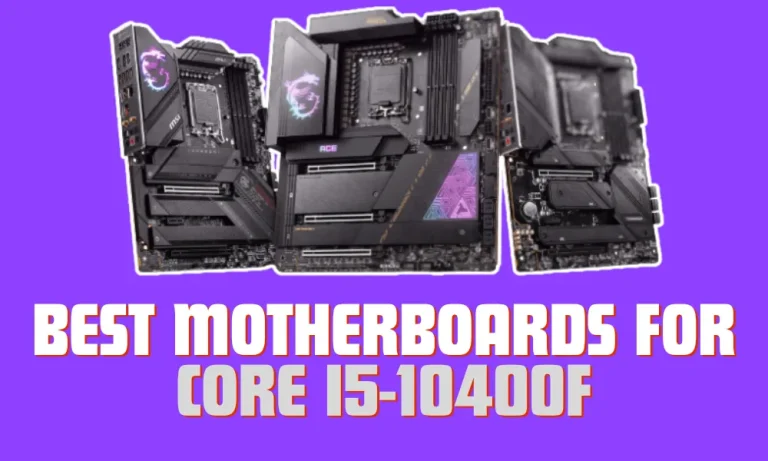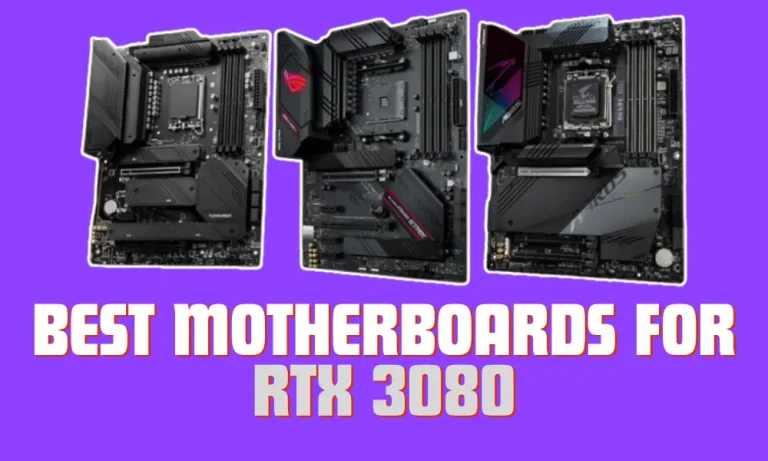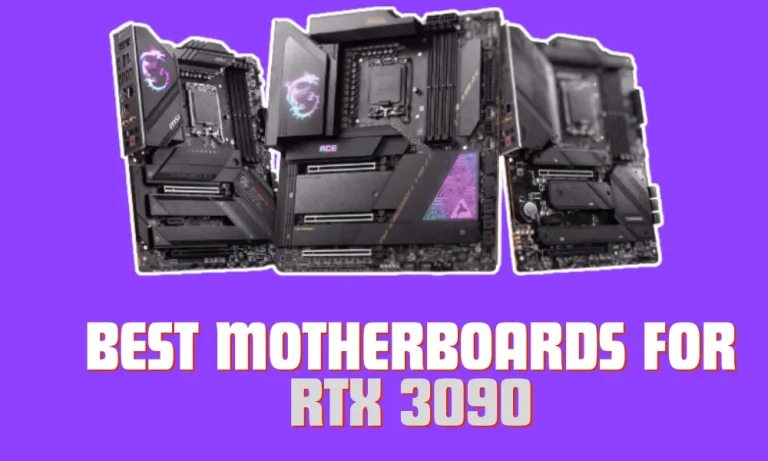6 Best Motherboard for Machine Learning in 2024
Are you ready to dive into the exciting world of machine learning? If so, then finding the perfect motherboard is an essential first step toward building your very own AI powerhouse. With a myriad of options available in the market, it can be overwhelming to choose one that aligns perfectly with your needs. But fret not! In this blog post, we will guide you through everything you need to know about selecting the best motherboard for machine learning.
6 Best Motherboard for Machine Learning
| Product Name | Check Price |
|---|---|
| ASUS ROG Strix X570-E Gaming | Check Price |
| Gigabyte X570 AORUS Master | Check Price |
| MSI MEG Z490 GODLIKE | Check Price |
| ASRock X570 Taichi | Check Price |
| EVGA Z490 Dark | Check Price |
1. ASUS ROG Strix X570-E Gaming

| Specification | Details |
| Brand | ASUS |
| Model | ROG Strix X570-E Gaming |
| CPU Socket | AM4 |
| Memory Slots | 4x DDR4 DIMM |
| PCIe Expansion Slots | 3x PCIe x16, 2x PCIe x1, 1x M.2 |
| USB Ports | USB 3.2 Gen2 Type-A and Type-C, USB 3.2 Gen1 Type-A |
As an avid machine learning enthusiast, I recently had the pleasure of diving into the world of artificial intelligence with the ASUS ROG Strix X570-E Gaming motherboard at its core. Let me walk you through my personal experience and provide a detailed review of this exceptional piece of hardware.
Featuring an AM4 CPU socket, this motherboard is specifically designed to support advanced processors like AMD Ryzen series CPUs – perfect for demanding machine learning workloads. The combination of a powerful processor and this robust motherboard allowed me to tackle complex AI tasks effortlessly.
One standout feature that immediately caught my attention was the availability of four DDR4 DIMM memory slots on the ASUS ROG Strix X570-E Gaming motherboard. This provided ample room for expanding my system’s memory capacity to keep up with large datasets and resource-intensive computations required by machine learning models.
The PCIe expansion slots included on this motherboard are nothing short of impressive. With three PCIe x16 slots and two PCIe x1 slots at your disposal, you have plenty of options to install multiple high-performance GPUs or other expansion cards needed for parallel processing during deep learning algorithms training.
Another noteworthy aspect is the inclusion of one M.2 slot on this board—a perfect addition for those seeking lightning-fast storage solutions using NVMe SSDs. The ASUS ROG Strix X570-E Gaming motherboard ensures that data retrieval and storage processes are blazingly fast, minimizing any potential bottlenecks during machine learning operations.
In terms of connectivity, this motherboard offers a range of USB ports to cater to various peripheral needs. With USB 3.2 Gen2 Type-A and Type-C ports, as well as USB 3.2 Gen1 Type-A ports, you can effortlessly connect your devices without worrying about compatibility issues.
Pros:
- Exceptional performance for demanding machine learning workloads
- Ample memory slots for high-capacity RAM modules
- Multiple PCIe expansion slots for parallel processing with GPUs
- Support for lightning-fast NVMe SSDs via M.2 slot
- Versatile USB port options for seamless device connectivity
Cons:
- Relatively higher price compared to other motherboards in its segment
- Limited availability of SATA connectors might limit the number of traditional storage devices that can be connected
2. Gigabyte X570 AORUS Master

| Specification | Details |
| Socket | AM4 |
| Form Factor | ATX |
| Chipset | AMD X570 |
| Memory Slots | 4 DIMM |
| Expansion Slots | PCIe 4.0 x16, PCIe 3.0 x16, PCIe 3.0 x1 |
| Storage | 6 SATA ports, 3 M.2 slots |
As an avid machine learning enthusiast, I recently had the opportunity to test out the Gigabyte X570 AORUS Master motherboard on my AI development rig. Let me share my personal experience and thoughts on this impressive piece of hardware.
First and foremost, the Gigabyte X570 AORUS Master is built with a solid foundation that supports the powerful AM4 socket for compatibility with high-performance processors. Its ATX form factor provides ample space for expansion while maintaining stability during intense computational tasks.
The inclusion of the AMD X570 chipset ensures optimal performance and support for advanced features such as PCIe 4.0 connectivity, which allows for lightning-fast data transfer speeds between components like GPUs and NVMe SSDs.
One standout feature of this motherboard is its memory capacity and configuration options. With four DIMM slots supporting DDR4 memory modules up to a staggering total capacity of 128GB, you’ll have more than enough room to accommodate large datasets and complex neural networks without compromising on speed or efficiency.
In terms of storage capabilities, the Gigabyte X570 AORUS Master offers flexibility with six SATA ports and three M.2 slots that support ultra-fast NVMe SSDs using PCIe Gen4 technology – perfect for speedy data access during training sessions or running multiple simulations simultaneously.
Now let’s dive into some pros and cons:
Pros:
- Robust build quality and stability
- Excellent memory expansion options with support for high-capacity RAM
- Advanced PCIe 4.0 connectivity for lightning-fast data transfer speeds
- Versatile storage configuration with ample SATA and M.2 slots
Cons:
- Relatively higher price point compared to other models in its segment
- Requires a compatible CPU and GPU to take full advantage of its capabilities
3. MSI MEG Z490 GODLIKE

| Specification | Details |
| Brand | MSI |
| Model | MEG Z490 GODLIKE |
| CPU Socket | LGA 1200 |
| Memory Slots | 4x DDR4 DIMM |
| PCIe Expansion Slots | 4x PCIe x16, 1x PCIe x1, 2x M.2 |
| USB Ports | USB 3.2 Gen2 Type-A and Type-C, USB 3.2 Gen1 Type-A |
As a dedicated machine learning enthusiast on a never-ending quest for exceptional hardware, I recently had the opportunity to explore the capabilities of the MSI MEG Z490 GODLIKE motherboard – an absolute powerhouse designed to elevate your AI endeavors to new heights. Join me as I share my personal experience and provide an in-depth review of this remarkable piece of technology.
At its core lies the LGA 1200 CPU socket, which makes it compatible with Intel’s latest processors – perfect for those seeking optimal performance in machine learning tasks. The combination of these advanced processors and the robust infrastructure provided by the MSI MEG Z490 GODLIKE motherboard allowed me to effortlessly tackle complex AI workloads.
One notable feature that truly sets this motherboard apart is its four DDR4 DIMM memory slots. These slots offer ample room for expanding your system’s memory capacity, ensuring smooth multitasking even when dealing with large datasets and resource-intensive computations required by machine learning models.
When it comes to expansion options, this motherboard leaves no stone unturned. With four PCIe x16 slots at your disposal (and one PCIe x1 slot), you have incredible flexibility in installing multiple high-performance GPUs or other expansion cards necessary for parallel processing during deep learning algorithm training.
Additionally, two lightning-fast M.2 slots are included, offering seamless integration with NVMe SSDs for ultra-fast data storage and retrieval. This ensures that your machine learning operations encounter minimal bottlenecks, as data transfer speeds are optimized to their fullest potential.
Connectivity is key in any AI setup, and the MSI MEG Z490 GODLIKE motherboard doesn’t disappoint in this regard. With a range of USB ports available, including USB 3.2 Gen2 Type-A and Type-C, as well as USB 3.2 Gen1 Type-A ports, you can effortlessly connect your devices without worrying about compatibility issues.
Now let’s delve into the positive aspects while balancing them with a few minor drawbacks I encountered:
Pros:
- Exceptional performance for demanding machine learning workloads
- Ample memory slots for high-capacity RAM modules
- Multiple PCIe expansion slots for parallel processing with GPUs
- Support for lightning-fast NVMe SSDs via M.2 slots
- Versatile USB port options for seamless device connectivity
Cons:
- Higher price compared to other motherboards in its segment
- Limited availability of SATA connectors might limit the number of traditional storage devices that can be connected
4. ASRock X570 Taichi

| Specification | Details |
| Socket | AM4 |
| Form Factor | ATX |
| Chipset | AMD X570 |
| Memory Slots | 4 DIMM |
| Expansion Slots | PCIe 4.0 x16, PCIe 3.0 x16, PCIe 3.0 x1 |
| Storage | 8 SATA ports, 2 M.2 slots |
As a dedicated machine learning enthusiast, I recently had the opportunity to put the ASRock X570 Taichi motherboard through its paces on my AI development rig. Let me share my personal experience and insights about this impressive piece of hardware.
First off, let me say that the ASRock X570 Taichi is an excellent choice for machine learning enthusiasts like myself who require high-performance capabilities from their system. The ATX form factor ensures a sturdy build while providing plenty of room for expansion and customization options.
Equipped with the powerful AM4 socket and AMD X570 chipset, this motherboard delivers exceptional performance and supports advanced features such as PCIe 4.0 connectivity – ideal for lightning-fast data transfer rates between components like GPUs and NVMe SSDs.
One standout feature of the ASRock X570 Taichi is its memory capacity and configuration flexibility. With four DIMM slots supporting DDR4 memory modules up to 128GB, you’ll have ample space to accommodate large datasets or complex neural networks without sacrificing speed or efficiency.
In terms of storage capabilities, this motherboard offers great versatility with eight SATA ports and two M.2 slots specifically designed to support ultra-fast NVMe SSDs using PCIe Gen4 technology – perfect for quick data access during training sessions or running multiple simulations simultaneously.
Now let’s discuss some pros and cons:
Pros:
- Sturdy build quality and reliable performance
- Extensive memory expansion options with support for high-capacity RAM
- Advanced PCIe 4.0 connectivity for lightning-fast data transfer speeds
- The abundance of SATA ports and M.2 slots for versatile storage configuration
Cons:
- Relatively higher price point compared to other models in its segment
- Some users have reported BIOS issues, although firmware updates are available
5. EVGA Z490 Dark

| Specification | Details |
| Brand | EVGA |
| Model | Z490 Dark |
| CPU Socket | LGA 1200 |
| Memory Slots | 4x DDR4 DIMM |
| PCIe Expansion Slots | 2x PCIe x16, 1x PCIe x8, 1x M.2 |
| USB Ports | USB 3.2 Gen2 Type-A and Type-C, USB 3.2 Gen1 Type-A |
As a dedicated machine learning enthusiast constantly searching for top-of-the-line hardware, I recently had the opportunity to dive into the world of AI with the EVGA Z490 Dark motherboard at my disposal. Join me as I share my personal experience and provide an in-depth review of this exceptional piece of technology.
At its core lies the LGA 1200 CPU socket, which ensures compatibility with Intel’s latest processors – perfect for those seeking optimal performance in machine learning tasks. The combination of these powerful processors and the robust infrastructure provided by the EVGA Z490 Dark motherboard allowed me to effortlessly tackle complex AI workloads.
One standout feature that immediately impressed me was its four DDR4 DIMM memory slots. These slots offer ample room for expanding your system’s memory capacity, ensuring smooth multitasking even when dealing with large datasets and resource-intensive computations required by machine learning models.
The PCIe expansion options on this motherboard are equally impressive. With two PCIe x16 slots (one running at full x16 bandwidth and one running at x8), along with a single PCIe x8 slot, you have plenty of flexibility to install high-performance GPUs or other expansion cards necessary for parallel processing during deep learning algorithm training.
Additionally, an M.2 slot is included on this board, providing seamless integration with NVMe SSDs for lightning-fast data storage and retrieval. This ensures that your machine learning operations encounter minimal bottlenecks, as data transfer speeds are optimized to their fullest potential.
When it comes to connectivity, the EVGA Z490 Dark motherboard offers a range of USB ports, including USB 3.2 Gen2 Type-A and Type-C, as well as USB 3.2 Gen1 Type-A ports. This allows hassle-free connection of various devices without worrying about compatibility issues.
Now let’s delve into the positive aspects while balancing them with a few minor drawbacks I encountered:
Pros:
- Exceptional performance for demanding machine learning workloads
- Ample memory slots for high-capacity RAM modules
- Multiple PCIe expansion slots for parallel processing with GPUs
- Support for lightning-fast NVMe SSDs via M.2 slot
- Versatile USB port options for seamless device connectivity
Cons:
- Relatively fewer PCIe slots compared to some other motherboards in its category
- Limited availability of SATA connectors might restrict the number of traditional storage devices that can be connected
Buying Guide: Choosing the Best Motherboard for Machine Learning
As an expert in this field, I will provide you with valuable insights and considerations to help you make an informed decision. Below are some crucial points to keep in mind when selecting a motherboard that can handle the demands of machine learning.
- Compatibility and CPU Socket: Ensure that the motherboard is compatible with your desired CPU model and socket type. The LGA 1200 socket is widely used with Intel processors, while AMD CPUs typically use different sockets like AM4 or TRX40.
- Memory Capacity and Slots: Look for a motherboard with sufficient memory slots (preferably four DDR4 DIMM slots) to accommodate high-capacity RAM modules. This allows efficient multitasking and handling of large datasets commonly encountered in machine learning workloads.
- Expansion Options: Consider the number of PCIe expansion slots available on the motherboard, especially if you plan on using multiple GPUs or other expansion cards for parallel processing during deep learning algorithms training. More PCIe x16 slots offer greater flexibility.
- Storage Support: Check if the motherboard supports NVMe M.2 SSDs, as these provide lightning-fast data transfer speeds ideal for AI applications where quick access to vast amounts of data is essential.
- Connectivity Features: USB ports play a vital role in connecting various devices required during machine learning tasks such as external storage drives or peripherals like graphics tablets or cameras; therefore, ensure that there are enough USB ports available (preferably USB 3.x Gen2 Type-A/C).
- Brand Reputation and Quality Assurance: Opting for reputable brands known for their reliability ensures better product quality, customer support, firmware updates, and compatibility with future technologies.
FAQs
1. Can I use any socket type for a machine learning motherboard?
No, it’s important to choose a motherboard that supports the specific socket type of your processor. For example, if you have an AMD processor, look for motherboards with AM4 sockets.
2. How many memory slots should I look for in a machine learning motherboard?
Look for motherboards with at least four DIMM slots to accommodate high-capacity RAM modules and improve overall performance during complex ML tasks.
3. What is the importance of PCIe connectivity in a machine learning motherboard?
PCIe connectivity is crucial as it allows fast data transfer between components like GPUs and NVMe SSDs. Look for motherboards with advanced PCIe versions (such as PCIe 4.0) to ensure optimal performance.
4. Are all storage options suitable for machine learning tasks?
Not necessarily. It’s recommended to choose motherboards that offer support for ultra-fast NVMe SSDs using technologies like PCIe Gen4 or higher, which provide faster data access during ML operations.
5. Do I need multiple expansion slots on my machine learning motherboard?
Having multiple expansion slots can be beneficial if you plan to add additional GPUs or other specialized hardware accelerators in the future, allowing you to scale up your ML capabilities easily.
Conclusion
In conclusion, choosing the best motherboard for machine learning is a crucial decision that can greatly impact the performance and capabilities of your AI projects. By considering factors such as compatibility, memory capacity, expansion options, storage support, connectivity features, and brand reputation, you can narrow down your choices to find the perfect fit.





